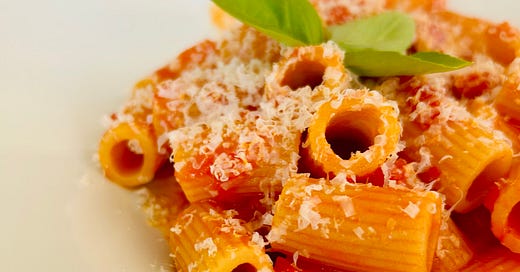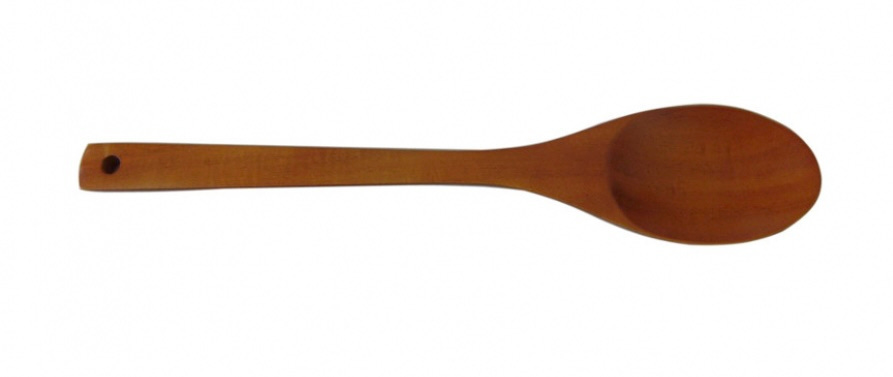I hope you enjoyed my piece on tomatoes and their usage in Italian cuisine from a couple of weeks ago.
In that article I mentioned home made passata, traditionally made once a year with rigorously fresh tomatoes. My mother makes it in a version which is already a kind of tomato sauce. She cooks the whole tomatoes directly with onions, carrots and celery, and the result is a sweet sauce quite low in acidity. She conserves the sauce in glass bottles and freezes them, ready to be defrosted and used for everyday needs (I promise I will share that recipe and technique another time).
But let’s face it, many Italians nowadays don’t have home made passata or salsa ready to use on the go, so we often make a quick sauce from scratch from tinned tomatoes or fresh tomatoes when in season.
North vs South?
There are different schools on what is the base for a tomato sauce. Most people would start with some form of soffritto. Soffritto is one of the foundations of Italian cuisine, and it usually involves one or more types of finely chopped allium (onion, garlic, shallot) gently cooked in a fat (oil, butter, lard). Sometimes other vegetables such as carrots and celery are added.
I always thought that the options with tomato sauce were to either to go with the “Northern” Italian way, with a sweeter final taste and a soffritto made with onions, often with carrot and celery, or to take the “Southern” route, using garlic in your soffritto and yielding a more aromatic and pungent result.
While in the process of writing this piece many doubts started to creep in. The north vs south “schools” is a rather simplistic way to look at this complex subject, and usually in food and music I try to stay away from simplistic stereotypes…the reality is always a much more interesting story! I also had many doubts about the onion and garlic used together issue. I personally have never seen anyone in my family mix these two options, it’s either garlic or onions, but after seeing them combined in many recipes (especially abroad), I started getting curious if anyone is actually using both at the same time in Italy. The final big question is the butter vs oil to finish the sauce. I had never heard of butter in tomato sauce until last year, when someone pointed out to me a reputable Italian recipe using it. To me at first, the idea of butter in tomato sauce sounded so wrong, you might as well throw some cream in it! But is that true for most Italians?
So I did a little research experiment. I made a post on my socials and on an Italian facebook community group to simply enquire how people make their everyday basic tomato sauce. The results are incredibly interesting and they show indeed a much more complex picture. Regionality is valid only to a certain extent and the results, if anything, show how much internal migrations have reshaped and reshuffled traditions in contemporary Italy, and how it’s really up to personal taste and family.
I will need some time to process the data and I will make a post in the near future that will analyse it and discuss the results in detail. For now I can only tell you that this little experiment proved one of the points I have been trying to make for a long time: In Italy there is never only one way to make a dish. Whoever tells you otherwise (plenty Italians will!) has either a very weak understanding of Italian culinary traditions and history, or they have other reasons to try to make you believe so.
I used to say as a joke that if you ask 200 nonne how they make tomato sauce, you will get 200 recipes, they will all be perfect and they will all be the only way to make tomato sauce. Well, I asked 200 Italians (and most of them gave me their nonna’s recipe) and I didn’t quite get 200 different recipes, but I got something slightly different every time.
My Way
As for today I am going to show you one of my favorite ways of making a quick classic tomato sauce, with a garlic light soffritto and fresh basil, and I can start by mentioning that it is the recipe that many Italians in my survey described in exactly the same way.
For this recipe I prefer to use whole canned tomatoes which I crush by hand at the beginning and then with a cucchiarella (the classic italian wooden spoon used for sauce) later in the process, but you can easily use a polpa di pomodoro instead.
The soffritto needs to be cooked very gently. The word soffritto come from the combination of the words sotto (under) and fritto (fried), so the whole idea is that it cooks below frying temperature. You are not supposed to burn the garlic, but give it some colour…if it gets dark brown, it’s burned and your sauce is gonna taste burned. Many Italians nowadays don’t like to eat garlic (a topic for another day), so they might use a whole garlic clove and infuse the oil with it at low temperature until it has absorbed some of the flavour. After a few minutes they remove the clove from the oil before adding the tomatoes. My mother always forgets to remove the clove, and every single person in my family knows the experience of putting a mouthful of pasta in your mouth and realising you are chewing on an entire clove of garlic.
This type of sauce cooks within 20-25 minutes. It’s a salsa that has texture and bite, as the tomatoes are hand crushed and not milled. For this reason I usually chose a small pasta format such as mezzi rigatoni or mezze maniche, but feel free to use whatever you like.
I usually start making the sauce as I put on a pot of water for the pasta to boil on the stove, and normally the pasta and the sauce are ready at the same time. The idea of very long cooking time for tomato sauce usually applies to a sugo that has a meat component, like a classic ragù, or a sauce with a piece of pork rib (like it’s traditional in Sicily) or with polpette (meatballs), but that is another story and shall be told another time.
Without further ado here comes the recipe
Salsa di pomodoro I
Serves 3
Keep reading with a 7-day free trial
Subscribe to Cooking by Ear to keep reading this post and get 7 days of free access to the full post archives.





